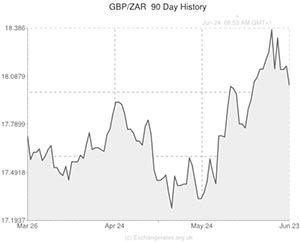
On Monday the Pound to Rand to exchange rate was trading 0.25% lower, in the region of 18.0370, as investors rediscovered their appetite for higher-risk currencies amid upbeat manufacturing figures from China.
Last week the Rand put on a mixed performance as domestic fundamentals (like the nation’s retail sales figures) came in above expected levels, while the mining strike continued and the situation in Iraq generated a risk-off environment.
The Rand was also feeling the pressure as a result of the decision of two of the world’s major credit ratings agencies to downgrade South Africa’s outlook to negative and credit rating to –BBB the previous week.
However, while the Pound was maintaining a bullish relationship with several of its peers amid speculation that the Bank of England will hike interest rates this year, the UK currency slid against the Rand, Australian Dollar and New Zealand Dollar as China’s Manufacturing PMI report lifted the latter three assets overnight.
As South Africa is a commodity-driven nation, the news that China’s manufacturing sector had returned to growth in June was well received. The HSBC Manufacturing PMI advanced from 49.4 to 50.8 this month, a much stronger result than the forecast of 49.7.
The threat of a slowdown in China has been a real concern among investors for some time, but this report indicates that the stimulus measures deployed by Chinese policy makers are helping the world’s second largest economy find its feet again.
The Rand held firm against the US Dollar after the data was published after hitting a ten-day high against the US asset at the close of last week. Advances were also made against the Pound and Euro.
In the opinion of forex expert Jim Bryson; ‘At the moment we are seeing strength based on the Chinese figures. Commodity prices are doing well so the Rand strength has a lot to do with what is happening globally’.
While Bryson intimated that the prospect of the mining strike in South Africa’s platinum sector coming to an end was a positive one, but indicated that action in the metalworking sector could soon follow.
The South African data to be aware of this week includes Thursday’s Producer Price Index.
Of course UK reports, like the nation’s final first quarter growth figures, could also influence the Pound to Rand (GBP/ZAR) exchange rate over the next few days.
Pound to Rand weaker as platinum strike ends – Updated 24/06/14
The South African Rand was continuing to tick higher against the Pound on Tuesday afternoon after the UK currency was weakened by comments made by Bank of England Governor Mark Carney and as the Rand found support from the ending of a five month strike in South Africa’s platinum mining sector.
BoE Governor Carney disappointed economists by saying that any rate hike would be gradual and that it depended upon the performance of the UK economy.
His focus upon wage growth was met with disappointment as that is one part of the economy that is flagging.
The end of the platinum miners’ strike caused the markets to breathe a sigh of relief as it had been seriously harming the South African economy.
Economists warned however that South Africa was not out of the woods yet as concerns over the nation’s power supply and a strike due to be held in the nation’s auto industry could weigh upon the Rand.

Comments are closed.